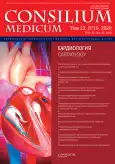Skin reactions to cardiac drugs: a clinical case
- Authors: Nevozinskaia Z.A.1,2, Piruzian A.L.3, Korsunskaia I.M.3
-
Affiliations:
- Pirogov Russian National Research Medical University
- Moscow Scientific and Practical Center for Dermatovenereology and Cosmetology
- Center for Theoretical Problems of Physicochemical Pharmacology
- Issue: Vol 22, No 10 (2020)
- Pages: 80-82
- Section: Articles
- URL: https://journals.rcsi.science/2075-1753/article/view/95368
- DOI: https://doi.org/10.26442/20751753.2020.10.200267
- ID: 95368
Cite item
Full Text
Abstract
Keywords
Full Text
##article.viewOnOriginalSite##About the authors
Zofiia A. Nevozinskaia
Pirogov Russian National Research Medical University; Moscow Scientific and Practical Center for Dermatovenereology and Cosmetologyканд. мед. наук, врач-дерматовенеролог Moscow, Russia
Anastas L. Piruzian
Center for Theoretical Problems of Physicochemical Pharmacologyд-р мед. наук, проф., гл. науч. сотр Moscow, Russia
Irina M. Korsunskaia
Center for Theoretical Problems of Physicochemical Pharmacology
Email: marykor@bk.ru
д-р мед. наук, проф., зав. лаб. Moscow, Russia
References
- Wilm A, Berneburg M. Photoallergy. J Dtsch Dermatol Ges 2015; 13: 7-12.
- Bylaite M, Grigaitiene J, Lapinskaite GS. Photodermatoses: classification, evaluation and management. Br J Dermatol 2009; 161 (Suppl. 3): 61-8.
- Honari G. Photoallergy. Rev Environ Health. 2014; 29: 233-42.
- Stein KR, Scheinfeld NS. Drug-induced photoallergic and phototoxic reactions. Expert Opin Drug Saf 2007; 6: 431-43.
- Ladizinski B, Elpern DJ. Dronaderone-induced phototoxicity. J Drugs Dermatol 2013; 12 (8): 946-7.
- Maoz KB, Dvash S, Brenner S, Brenner S. Amiodarone-induced skin pigmentation and multiple basal-cell carcinomas. Int J Dermatol 2009; 48 (12): 1398-400. doi: 10.1111/j.1365-4632.2008.03819.x
- Lankerani L, Baron ED. Photosensitivity to exogenous agents. J Cutan Med Surg 2004; 8 (6): 424-31.
- Drucker AM, Rosen CF. Drug-induced photosensitivity: culprit drugs, management and prevention. Drug Saf 2011; 34 (10): 821-37. doi: 10.2165/11592780-000000000-00000
- Jaworski K, Walecka I, Rudnicka L et al. Cutaneous adverse reactions of amiodarone. Med Sci Monit 2014; 20: 2369-72. doi: 10.12659/MSM.890881
- Bongard V, Marc D, Philippe V et al. Incidence rate of adverse drug reactions during long-term follow-up of patients newly treated with amiodarone. Am J Ther 2006; 13 (4): 315-9.
- Ammoury A, Michaud S, Paul C et al. Photodistribution of blue-gray hyperpigmentation after amiodarone treatment: molecular characterization of amiodarone in the skin. Arch Dermatol 2008; 144 (1): 92-6. doi: 10.1001/archdermatol.2007.25
- Yones SS, O'Donoghue NB, Palmer RA et al. Persistent severe amiodarone-induced photosensitivity. Clin Exp Dermatol 2005; 30 (5): 500-2.
- Shah N, Warnakulasuriya S. Amiodarone-induced peri-oral photosensitivity. J Oral Pathol Med 2004; 33 (1): 56-8.
- Rappersberger K, Honigsmann H, Ortel B et al. Photosensitivity and hyperpigmentation in amiodarone-treated patients: incidence, time course, and recovery. J Invest Dermatol 1989; 93: 201-9.
- Vassallo P, Trohman RG. Prescribing amiodarone: an evidence-based review of clinical indications. JAMA 2007; 298 (11): 1312-22.
- Ferguson J, Addo HA, Jones S et al. A study of cutanous photosensitivity induced by amiodarone. Br J Dermatol 1985; 113: 537-49.
- Dereure O. Drug-induced skin pigmentation. Epidemiology, diagnosis and treatment. Am J Clin Dermatol 2001; 2 (4): 253-62.
Supplementary files






